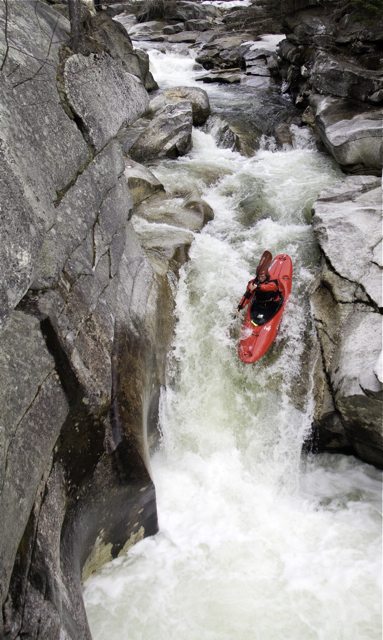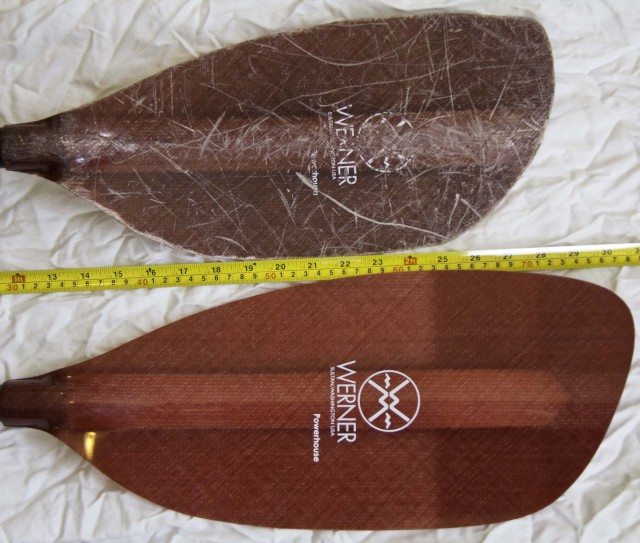
Werner Powerhouse, Straight Shaft
Size: 200cm
Listed Specs:
- 30-degree right-hand control
- Standard shaft diameter
Blade:
- Surface Area: 720 sq cm
- Length x Width: 48 x 19.5 cm
- Material: Fiberglass
- Design: Large river-running blade
MSRP (Straight Shaft): $250
Days Tested: ~300 (all on one paddle)
Locations Tested: Chile, Northeast U.S., Quebec, Ontario, Colorado, and Pacific Northwest on all types of rivers
Review Stats: 6’ 2” with wingspan of 6’ 3.25”, 200lbs
When it comes to choosing a paddle, there are a lot of options on the market. Blade feel in the water, ergonomics, and durability all matter, and people looking for a affordable paddle that strikes a good balance between those three considerations usually end up with a Werner Powerhouse.
The Powerhouse is Werner’s “premium” level river running paddle with full-size blades. It’s made of continuous weave fiberglass with a foam stiffener in the middle of the blade for buoyancy and rigidity.
Straight Shaft
The straight shaft Powerhouse has ovalized grips that help indicate blade angle and hand placement. One of the primary reasons I prefer straight shaft paddles is because I can grab the paddle wherever I want and still have a consistent grip. There are a limited number of places where you can put your hands when you’re using a bent shaft, and I don’t like having to think about this when grabbing the paddle quickly.
(If you’re looking for a detailed discussion on the benefits of a straight shaft versus a bent shaft, refer back to Blister’s paddle symposium).
Blade Catch
With the exception of the foam stiffener, the blade profile on the Powerhouse is thin, and I noticed the blade catch immediately.
The thin leading edge grabs the water quickly and cleanly, and the large blade feels very powerful. When you’re using the proper technique, the blade exits the water smoothly, but I did find that if your blade control gets sloppy, the large surface area and thin edges can hang you up when trying to release a stroke.

Blade Surface
I noticed the large blade surface as soon as I took the first few strokes. It gives you a lot of power, but when I’m not in great paddling shape, I found the blade size would tire me out quickly.
The large paddle blades on a stiff shaft can also be hard on my shoulders, but thankfully the flex in the Powerhouse’s fiberglass shaft alleviated that strain. Flexible blades sacrifice power, but having some flex in the shaft can prevent a lot of shoulder pain. Shaft flex can also add snappiness to strokes, making deep-water boofs and quick, powerful forward strokes clean and crisp.
The low / moderate dihedral on the power face keeps flutter down without sacrificing the ability to make in-water stroke recovery, and the back face provides a consistent, stiff surface for backstrokes.
Foam Stiffener
The blade has only a small foam stiffener, so technical strokes like gliding draws don’t have a pronounced buoyant feel. This also means the paddle doesn’t offer much help when bracing or rolling in heavily aerated water.
When I paddle with full foam core blades like those on the Werner Shogun or the high-end AT Paddles (AT2, Superduty, Superlight, etc.), the paddle provides significantly more support when I’m bracing or rolling. These blades, with their thicker profiles and foam cores, allow for smooth in-water recoveries on draws or braces. But while full foam core blades are more buoyant, they usually lack the Powerhouse’s initial bite in a stroke.
And whatever the Powerhouse’s fiberglass blades lack in support, they make up for in both price and durability…
Durability
I’ve never worried about breaking this paddle.
The fact that I’ve used it for over 300 days on the river says something about how this paddle is made. I’ve used the Powerhouse on more or less every type of river out there, from way-too-low rock piles, to juiced up bigwater, to stacked waterfall runs. And while I don’t dish out outrageous abuse to my paddles, I’m also not very kind to them.
Instead of a catastrophic failure, the blade surface has slowly shrunk over the course of three years. The fiberglass blades wear down against rocks, and my paddle blades are significantly smaller than when I first bought the paddle.

I think there’s something to be said for this predictable wear—I know that I likely won’t break the Powerhouse in the line of duty.
I’ve seen paddlers use tricks, most involving duct tape or paddle-edge protector kits, to combat this gradual wearing down. I avoid these schemes for one reason—I don’t like the way paddle blades feel when they have taped or glued edges. Flutter increases and you get odd drag in strokes when there’s extra material on the leading and trailing edges.
There’s another side benefit of this gradual wear. What started out as a large-blade river running paddle is now a perfectly acceptable playboating paddle (albeit one that’s a little long), and I now regularly use my Powerhouse to surf. Granted, playboating certainly isn’t this paddle’s strenght…
